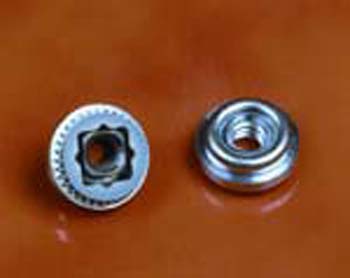Self-Clinching Floating Nuts
In this guide, we will explore the world of these innovative and reliable fastening solutions that provide a secure and versatile method for attaching components in various applications. Self-clinching floating nuts, also known as self-aligning nuts, are designed to be permanently installed by pressing them into pre-punched holes in metal sheets or panels. These nuts feature a unique floating thread design that allows them to self-align with mating screws, accommodating slight misalignments during assembly and ensuring a strong and stable connection.
Key Features and Benefits
Self-clinching floating nuts offer a wide range of features and benefits that make them an indispensable part of any fastening solution. Let's explore some of their key advantages:
- Floating Thread Design: The floating thread design allows the nut to self-align with mating screws, even when the components are slightly misaligned, ensuring a secure and accurate connection.
- Simple Installation: The installation process involves pressing the nut into a pre-punched hole, eliminating the need for additional hardware or tools.
- Secure Attachment: Once installed, self-clinching floating nuts create a strong and permanent threaded post, providing a reliable fastening solution.
- High Strength: Despite their small size, these nuts offer excellent load-bearing capacity, making them suitable for various applications.
- Versatile Applications: Self-clinching floating nuts are widely used in industries such as electronics, automotive, aerospace, industrial machinery, and more.
- Space-Saving: These nuts have a low-profile design, ensuring minimal protrusion from the panel surface and optimizing space in compact assemblies.
- Materials and Finishes: Self-clinching floating nuts are available in various materials, including stainless steel, steel, and aluminum, with optional plating or coatings for enhanced performance in different environments.
- Cost-Effective: These nuts streamline the assembly process, leading to increased efficiency and reduced labor costs.
Types of Self-Clinching Floating Nuts
Self-clinching floating nuts come in different styles and sizes to accommodate various application requirements. Some common types include:
- Round Floating Nuts: These nuts have a round shape and are commonly used in applications where a low-profile and flush appearance is desired.
- Hexagonal Floating Nuts: These nuts have a hexagonal shape, allowing for easy installation using standard tools like wrenches or sockets.
- Blind Floating Nuts: These nuts have a closed bottom end, making them ideal for applications where the bottom side of the panel is not accessible.
- Thru-Hole Floating Nuts: These nuts have a threaded shank that extends through the panel, providing a threaded post on both sides.
Applications
Self-clinching floating nuts find numerous applications across various industries due to their secure and versatile fastening capabilities. Some common applications include:
- Electronics: Used in PCBs, electronic enclosures, and racks for secure fastening of components and panels.
- Automotive: Found in automotive assemblies for attaching interior panels, dashboards, and electronic modules.
- Aerospace and Aviation: Used in aircraft interiors, avionics, and cabin assemblies for critical and high-reliability applications.
- Industrial Machinery: Utilized in control panels, industrial equipment, and robotics for efficient and reliable fastening.
- Telecommunications: Found in networking equipment and data centers for mounting and securing electronics.
- Consumer Electronics: Employed in smartphones, laptops, and other devices for compact and secure fastening.
- Medical Devices: Used in medical equipment and devices for attaching components and panels securely.
- Lighting Fixtures: Found in LED lighting assemblies for secure mounting and ease of installation.
Installation Process
The installation of self-clinching floating nuts is a straightforward process that involves the following steps:
- Preparation: Ensure that the panel has the correct hole size and design for the specific nut.
- Insertion: Insert the nut into the pre-punched hole.
- Application of Force: Using a press or installation tool, apply sufficient force to the nut to clinch it securely into the panel material.
- Verification: Confirm that the nut is correctly installed and providing a secure threaded post.
Quality Assurance
At OneMonroe, we prioritize quality and reliability in every self-clinching floating nut we produce. Our manufacturing processes adhere to stringent quality standards, and our experienced team of engineers and technicians ensures that each nut meets or exceeds industry specifications. We are committed to providing products that you can trust for your critical applications.
Conclusion
Experience the security and versatility of self-clinching floating nuts in your assemblies. These innovative fasteners offer a strong and stable connection, making them suitable for a wide range of applications. Order your self-clinching floating nuts today and discover the convenience and reliability they bring to your projects.










